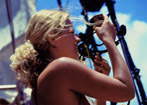|
Suva, Fiji
29th April - 24th May
2005
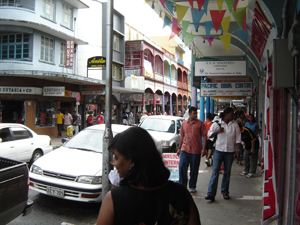
one of the 'Indian' streets
in downtown Suva
By now we had heard a great deal
about Suva and were very keen to explore this multi-cultural city,
its people, cinemas, cafes, thriving yacht club scene, stores and
nightclubs.
Our purpose here was to replace
our very old and faithful anchor winch, a cast iron monument constructed
in Scotland a long time ago, to be replaced by a brand new and shining
white winch from Tasmania with gleaming brass fittings. We were
on a tight deadline, as ever, and in just two days the old winch
sat forlornly on the dock while the new took its rightful place
on our bow.
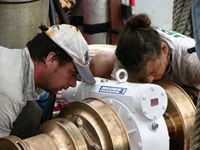

the winch team in action!
While alongside the dock, we were sandwiched
to it by a Chinese fishing boat which tied up to us for our stay
– half the crew were Chinese, half Indonesian, all very young
and none able to communicate with us in English. There are many
Chinese fishing vessels in Fiji, afforded fishing rights through
the sale of licenses, but there are also many more that have been
impounded by the Fisheries Department and are tied up to each other
in Suva harbour for illegal fishing activities. It was quite revealing
to have such a close look at such a boat and see first-hand the
low state of seamanship and living conditions these crews suffer
at sea. As they released their lines from us to allow us to head
away from the dock, they leaned over heavily to portside. For a
moment we all thought the boat was about to sink in the middle of
the harbour. Their crew cheered and laughed while running across
to starboardside to counter their dramatic list.
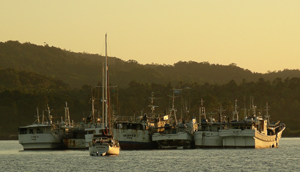
boats impounded for illegal
fishing practices
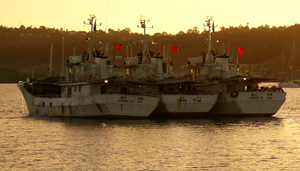
a few of the many Chinese
fishing boats working Fiji's waters
Suva serves as a focal point for much of the
South Pacific – culturally, logistically and commercially.
We discovered a healthy scattering of coral reef scientists working
with different organisations, tapping into a network of observations
on the state of Fiji’s reefs and establishing a collaborative
relationship with the Wildlife Conservation Society. We made plans
with them on how best we could use our time here in Fiji. They are
running a project right now, the Seascape Project, hoping to create
marine protected areas along the Southern coast of Vanua Levu and
into the Vatu Ira Channel and Bligh Waters. We decided to return
in June to Namena, which is part of this project, to carry out baseline
studies on the already established marine protected area.
Chili Hawes, Director of the October
Gallery in London, visited us and instigated a great bond between
the Heraclitus and Dr Epeli Hau'Ofa who has created a very beautiful
concept in the Oceania Centre, at the University of the South Pacific.
Here musicians, artists, dancers gather to integrate their Pacific
identities into an Oceanic tribe and to explore their own cultures
and others.
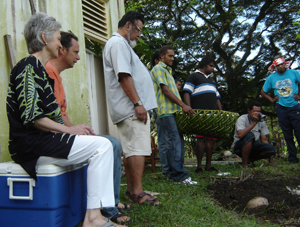
Chili, Laser, Dr Epeli Hau'Ofa
at the side of the 'lovo' earth oven at the Oceania Centre
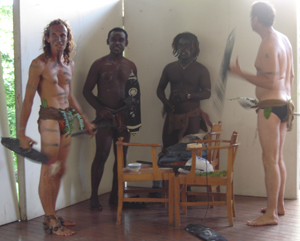
Michel, Paul, Eddie and Laser
preparing to perform the Eomba at the Centre
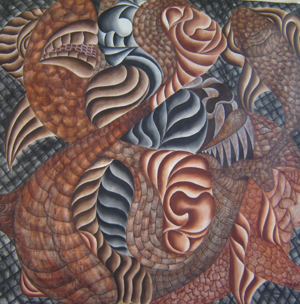
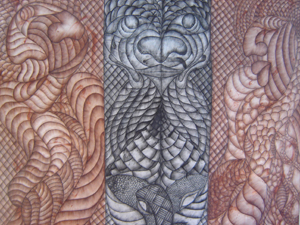
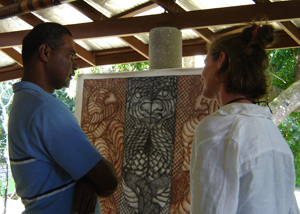
Orla with Willy, one of the
artists Chili met while in Fiji
Mau
Passage (S
16° 46.4’ E 179° 19.4’)
We brought the ship to Mau Passage for a weekend,
about twenty miles west of Suva. Here we were happy to explore underwater
again since diving in Suva harbour is not recommended - there have
been sightings of six foot long tiger sharks! Sadly, the inner bay
laced with seagrass and surrounded by mangroves proved to be a more
vivid landscape than the one we found underwater although we did
not have time to fully explore the area and all its reefs.
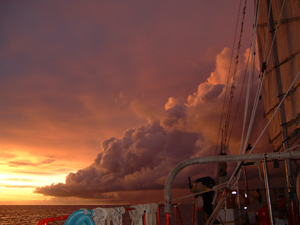
Back to Suva, its hustle and bustle and a long
wait for a much-needed generator part. We busied ourselves as one
can so easily do in a city and prepared for our trip to Kadavu.
|


